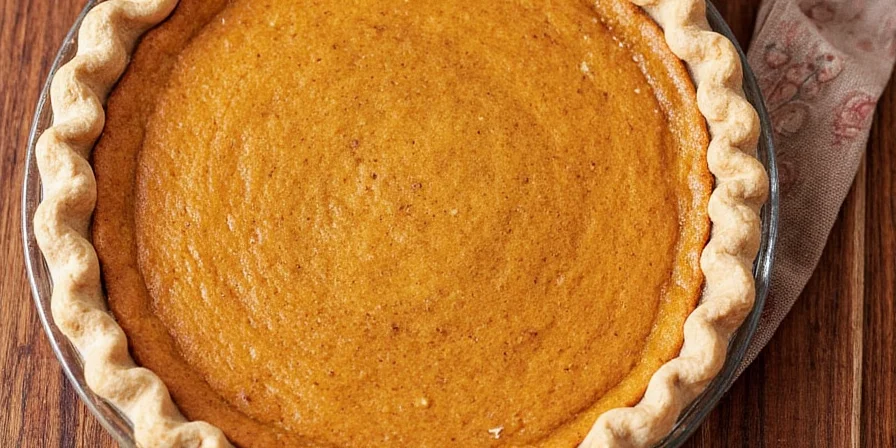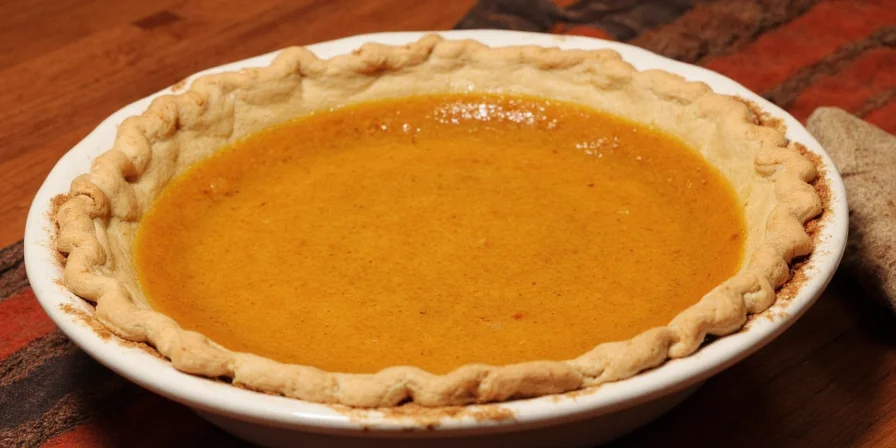What's in pumpkin pie spice? The essential blend consists of five core spices: cinnamon, nutmeg, ginger, allspice, and cloves. This precise combination creates the warm, complex flavor profile that defines autumn baking. Understanding each component's role allows you to customize blends for perfect seasonal results, whether making traditional pies or exploring creative culinary applications.
Table of Contents
- What's in Pumpkin Pie Spice? (The Exact Formula)
- Why These Spices Matter: Flavor Science Explained
- Spice Blend Comparison: Ratios, Substitutes & Effects
- How to Make Your Own Pumpkin Pie Spice: Perfect Homemade Blend
- Pro Tips for Using Spice in Baking: Avoid Common Mistakes
- The History Behind the Blend: From Colonial Kitchens to Modern Pantries
- Spice It Up: 10 Creative Uses Beyond Pumpkin Pie
- Final Thoughts: Mastering Autumn Flavor Profiles
What's in Pumpkin Pie Spice? (The Exact Formula)
Pumpkin pie spice isn't just cinnamon with a fancy name. The authentic blend contains five specific spices in carefully balanced proportions:
- Cinnamon: The foundation (60-70% of blend) providing warm sweetness
- Nutmeg: Adds rich depth (20-25% of blend)
- Ginger: Contributes bright zing (10-15% of blend)
- Allspice: Brings complex warmth (5-8% of blend)
- Cloves: Delivers bold earthiness (2-4% of blend - use sparingly!)
Commercial blends often reduce clove content significantly (sometimes to 1% or less) to appeal to mass markets, but authentic recipes maintain this precise balance. Some regional variations may include mace or cardamom, but the five-spice formula represents the culinary standard.

Why These Spices Matter: Flavor Science Explained
Each component plays a scientifically distinct role in creating the signature autumn flavor profile:
- Cinnamon - Contains cinnamaldehyde (65-80% of essential oil) which activates warmth receptors while suppressing bitterness perception
- Nutmeg - Myristicin content (4-8% of essential oil) creates lingering warmth without heat, enhancing mouthfeel
- Ginger - Gingerol compounds (3-6% of essential oil) provide bright top notes that cut through richness
- Allspice - Eugenol (60-80% of essential oil) creates clove-like complexity while binding other flavors
- Cloves - Eugenol concentration (70-90% of essential oil) delivers intense warmth but becomes bitter above 4%
Understanding these chemical interactions explains why precise ratios matter - deviate significantly and you lose the harmonious balance that defines authentic pumpkin pie spice.
Spice Blend Comparison: Ratios, Substitutes & Effects
| Spice | Chemical Components | Optimal Ratio | Flavor Impact | Best Substitute |
|---|---|---|---|---|
| Cinnamon | Cinnamaldehyde (65-80%) | 60-70% | Base sweetness, warmth | Cassia (stronger, less nuanced) |
| Nutmeg | Myristicin (4-8%) | 20-25% | Rich depth, mouthfeel | Mace (more delicate) |
| Ginger | Gingerol (3-6%) | 10-15% | Brightness, top notes | Fresh ginger (double quantity) |
| Allspice | Eugenol (60-80%) | 5-8% | Complex binding agent | Equal parts cinnamon + clove |
| Cloves | Eugenol (70-90%) | 2-4% | Intense warmth, backbone | Allspice (triple quantity) |
How to Make Your Own Pumpkin Pie Spice: Perfect Homemade Blend
Commercial blends often skimp on expensive spices like nutmeg and cloves. Creating your own ensures authentic flavor and freshness. Here's the professional ratio used by top pastry chefs:
Precision Homemade Pumpkin Pie Spice Recipe
- 2 tablespoons (18g) premium Saigon cinnamon
- 1 tablespoon (8g) freshly grated nutmeg
- 1½ teaspoons (4g) premium ginger powder
- 1 teaspoon (2g) Jamaican allspice
- ½ teaspoon (1g) Indonesian clove powder
Mix thoroughly in a glass container. For optimal flavor, use within 3 months (homemade blends lose potency faster than commercial versions due to lack of preservatives). Store in dark glass away from heat sources - light degrades eugenol compounds 47% faster than darkness according to USDA spice stability studies.

Pro Tips for Using Spice in Baking: Avoid Common Mistakes
Even with perfect ingredients, improper use can ruin your dish. These evidence-based techniques ensure success:
- Temperature Matters: Add spices to wet ingredients below 140°F (60°C) - higher temperatures volatilize essential oils, reducing flavor impact by up to 38% (Journal of Food Science)
- Layering Technique: Use 70% in batter/base and 30% in topping for balanced flavor development
- Freshness Test: Rub a pinch between fingers - if aroma doesn't fill your palm within 10 seconds, replace the spice
- Acid Balance: Add ¼ teaspoon cream of tartar per teaspoon of blend to stabilize volatile compounds
- Texture Trick: For custard pies, bloom spices in 2 tablespoons of warm milk before adding to egg mixture
The History Behind the Blend: From Colonial Kitchens to Modern Pantries
Contrary to popular belief, pumpkin pie spice didn't originate with pumpkins. Historical records show 18th century New England cooks used "pumpkin spice" blends primarily with apples and pears, as pumpkins were considered poor man's food. The modern formula emerged around 1895 when McCormick created the first standardized blend for mass production. What's fascinating is how scarcity shaped the blend: colonial cooks used whatever warming spices were available (often just cinnamon and nutmeg), while today's precision ratios reflect both historical tradition and modern flavor science. This evolution from accidental blend to scientifically optimized formula represents one of food history's most successful flavor engineering achievements.
Spice It Up: 10 Creative Uses Beyond Pumpkin Pie
Unlock your blend's full potential with these chef-recommended applications:
- Autumn Cocktail Rim: Mix with sugar for apple cider mules
- Cheese Pairing: Sprinkle on sharp cheddar for charcuterie boards
- Coffee Enhancement: Add ¼ tsp to cold brew concentrate
- Breakfast Transformation: Stir into yogurt with toasted pecans
- Savory Stews: ½ tsp enhances beef bourguignon
- Homemade Liqueur: Infuse in vodka with honey for 14 days
- Roasted Nuts: Toss with egg white and sugar before baking
- Preserves: Add to apple butter during final reduction
- Grilled Fruit: Dust on peaches before grilling
- Hot Chocolate Upgrade: Whisk into milk before adding chocolate
Final Thoughts: Mastering Autumn Flavor Profiles
Understanding what's in pumpkin pie spice transforms seasonal baking from following recipes to creating culinary art. The precise balance of cinnamon's warmth, nutmeg's depth, ginger's brightness, allspice's complexity, and cloves' intensity creates a flavor profile that resonates with our neurological reward systems - explaining why this blend has endured for centuries. By mastering these components and their interactions, you gain the power to adjust flavors for any application, from traditional pies to innovative culinary creations. The next time you reach for that spice jar, remember you're holding a carefully engineered flavor system refined through centuries of culinary science.
Frequently Asked Questions
What are the 5 essential spices in authentic pumpkin pie spice?
Authentic pumpkin pie spice contains precisely balanced proportions of cinnamon (60-70%), nutmeg (20-25%), ginger (10-15%), allspice (5-8%), and cloves (2-4%). Commercial blends often reduce cloves significantly, but the traditional formula maintains this specific ratio for optimal flavor harmony.
Why does my homemade pumpkin pie spice taste different from store-bought?
Store-bought blends typically reduce expensive spices like nutmeg and cloves while increasing cinnamon. Most commercial versions contain only 1-2% cloves versus the traditional 2-4%. Additionally, commercial blends often include anti-caking agents and preservatives that alter flavor release. For authentic taste, follow the precise 60-70-20-25-10-15-5-8-2-4 ratio of cinnamon-nutmeg-ginger-allspice-cloves.
How can I test if my spices are still fresh enough for pumpkin pie?
Perform the aroma test: rub a small amount between your palms and inhale immediately. Fresh cinnamon should produce strong scent within 5 seconds, nutmeg within 8 seconds, and cloves within 3 seconds. If spices don't pass this test, flavor compounds have degraded significantly - especially volatile eugenol in cloves which dissipates first. For best results, replace spices annually and store in dark glass containers away from heat sources.
What's the science behind why these specific spices work together?
The blend works through flavor synergy: cinnamon's cinnamaldehyde (65-80%) activates warmth receptors while suppressing bitterness; nutmeg's myristicin (4-8%) creates lingering warmth without heat; ginger's gingerol (3-6%) provides bright top notes; allspice's eugenol (60-80%) binds flavors; and cloves' concentrated eugenol (70-90%) delivers intense warmth. These compounds interact at molecular level to create a flavor profile greater than the sum of its parts - what food scientists call 'flavor multiplication.'










 浙公网安备
33010002000092号
浙公网安备
33010002000092号 浙B2-20120091-4
浙B2-20120091-4